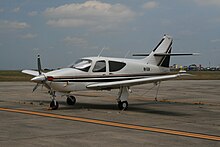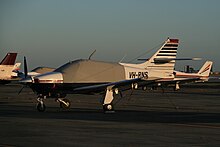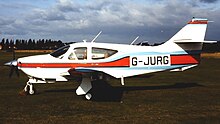Rockwell Commander 112
| Commander 112/114 | |
|---|---|

|
|
| Type: | Small plane |
| Design country: | |
| Manufacturer: | |
| First flight: |
4th December 1970 |
| Commissioning: |
1972 |
| Production time: |
1972-1980, 1992-2002 |
| Number of pieces: |
approx. 1,200 |
The Rockwell Commander 112 is a single-engine, four-seat light aircraft of the US manufacturer Rockwell , which was built from the 1972nd In 1976 Rockwell introduced the turbo-charged version 112TC and the Rockwell Commander 114 , equipped with a larger engine and other minor improvements . A total of 1,000 units of these machines were built before production of the series was discontinued in 1980.
The rights to the construction were sold to Commander Aircraft in 1988. Commander Aircraft redesigned the interior , introduced some minor improvements and released the Commander 114B in 1992 . About 200 units of this model were built before production ended in 2002. The last reincarnation of the Commander was introduced by Commander Aircraft in January 2001 with the Commander 115 .
development
Initial production

In 1970 Rockwell's “Aero Commander” department developed a new series of aircraft that should cover all models from a four-seater with a rigid landing gear to a two -engine six-seater with retractable landing gear. The first models in the series were two versions of a four - seater low - wing aircraft - the Commander 111 with a rigid and the Commander 112 with a retractable nose wheel landing gear . The 111 was to be sold for $ 17,950 (adjusted for inflation: 117,939) and the 112 for $ 22,100 (adjusted for inflation: 145,206). However, only two prototypes of the Commander 111 were made before the company decided to just build the Commander 112 in series .
The draft featured a modern design and a significantly larger interior space than older patterns like the Piper Cherokee and the Beechcraft Bonanza . Or as one reviewer put it:
“If people bought airplanes based on looks and roominess alone, there would likely be a lot more Rockwell Commanders out in the field. This stout, four-seat single has a stylish look that is noticeably absent among many airplane designs dating to the 1950s and '60s. On the ramp the Commander's rakish nose, towering tail, and upright stance set it apart from its dowdy-looking competitors. Likewise, its interior volume is closer to that of a cabin-class twin than other four-seat singles. "
“If planes were bought on the basis of looks and space, there would likely be many more Rockwell Commander. This stocky, single-engine four-seater has a sleek look that many aircraft from the 1950s and 1960s lack. With its sleek nose, the towering rear and the entire upright posture, the Commander clearly sets itself apart from its homely competitors. Its interior is also closer to that of a twin-engine cabin aircraft than other single-engine four-seaters. "
The design was designed to meet the then new FAR Part 23 for light aircraft , which placed emphasis on wind gust resistance and the prevention of material fatigue. The resulting construction therefore had considerable strength - a property that Rockwell has extensively marketed. Unfortunately, it has an impact on performance, which made the Commander 112 slightly slower than similar machines like the Piper Arrow.
After a prototype of the Commander 112 crashed due to a broken tail, the tail was redesigned. This delayed delivery of the first machine until the end of 1972. The changes resulting from the incident also led to an increase in weight and thus to the fact that the Commander 112 was significantly underpowered. The prototype of the 112 was powered by a Lycoming O-360 with 180 PS (132 kW), which was replaced for series production by an IO-360 with 200 PS (147 kW). However, the machine was still underpowered. Another drawback was that the GRP doors did not fit properly and tended to leak.
New versions
After 123 aircraft were built, some improvements were introduced in 1974 which led to the Commander 112A. The GRP doors were replaced by doors made of aluminum , which added weight but resulted in a quieter interior. The wings were also changed, increasing the tank capacity and increasing the MTOW by 100 lb (45 kg ) to 2,650 lb (1,202 kg). After another 30 units were built, Rockwell offered an option to further increase the tank capacity from 48 to 68 US gallons .
In 1976, two new models were added to the range - the Commander 112TC with a turbocharged 210 hp (154 kW) engine and an MTOW of 2,850 lb (1,293 kg) and the Commander 114 with a Lycoming IO-540 with six cylinders and 260 PS (191 kW). The 112TC has a significantly higher cruising speed of 160 kn (296 km / h ) at higher altitudes of up to 20,000 ft (6,096 m ) and a 32 in (0.8 m ) increased wingspan . The weak climb performance makes these advantages usable only on long flights, where the climb time does not play a role. In comparison, the 114 has a far more suitable engine , which offers roughly the same cruising speed even at lower altitudes and, thanks to the higher performance, a far better climbing performance.
In 1977, the increase in the wingspan of the TC model was also applied to the base model 112, resulting in the Commander 112B. The 112B thus had an increased MTOW of 2,800 lb (1,270 kg) and thus a respectable payload of 1,000 lb (454 kg). Production of the 112B ended in 1979 while the 112TC continued to evolve with a 50 lb (22.7 kg) increase in MTOW and other minor changes. The most obvious change was a complete redesign of the avionics with a three-axis autopilot . That improved model was the 112TCA Alpine. The improvements were little more powerful than the original 112TC. The aircraft was more expensive than offers from other manufacturers. Other small improvements such as a three-blade propeller and a slightly increased MTOW of 3,250 lb (1,474 kg) formed the 114A Gran Turismo. The 112TCA and 114A remained in production until 1980 before Rockwell discontinued the series with over 1,000 units shipped.
Commander Aircraft
After the end of production, Rockwell sold the rights to all designs of the Aero Commander division in 1981 to Gulfstream Aerospace . Gulfstream, however, was only interested in the Aero Commander 500 and stopped producing the Commander 112/114 series. In 1988, Gulfstream sold the rights to Randall Greene, who founded Commander Aircraft to service the existing aircraft and build new aircraft.
The design received many improvements and was produced again in 1992 as the Commander 114B. Among the changes were a more streamlined cowling , a reinforced airframe , changes to various air intakes and a new propeller . This increased the cruising speed by 8 knots (15 km / h) and thus improved competitiveness with similar models from other manufacturers. Other significant changes were made to the interior. This involved a high-quality leather interior , reading lamps, improved noise protection and an optional, powerful air conditioning system . Carl Marbach from AVweb put it this way: "An ultra-spacious interior that looks more like a luxury car than a sardine can."
In 1995 the 114TC was added, which is a 114B with a turbo-charged engine with an output of 260 hp (191 kW). Primarily this increased the cruising speed at high altitudes to just over 200 kn (370 km / h). The company primarily marketed the aircraft in unconventional markets - specifically to Wall Street executives - through magazines and newspapers such as the Wall Street Journal , Forbes, and Fortune, as well as to Middle Eastern business people for whom the high-performance air conditioning was intended.
In January 2000, the company introduced the Commander 115, powered by a Lycoming IO-540 with 260 hp (191 kW), and the 115TC, powered by a Lycoming TIO-540 with 270 hp (199 kW). Outwardly, the machines are similar to their predecessors 114 and 114TC, but have a tank capacity of 90 US gallons and revised avionics . In addition to these improvements, various special equipment such as a de-icing system from TKS were available.
Commander Premier Aircraft
In 2005, the Commander Premier Aircraft Corporation (CPAC) was founded by over fifty Commander owners to ensure the availability of spare parts. The company purchased the assets from the bankruptcy administrator of Commander Aircraft in mid-2005 and moved all manufacturing equipment from Oklahoma City to a new location in Cape Girardeau , Missouri .
In addition to the production of the 115 and the 115TC, the sale of the 115AT (“Advanced Trainer”), a slimmed-down version with a simple interior, was planned for flight schools looking for a high-performance training aircraft.
Commander Premier Aircraft was to be sold in 2009 to Aero-Base, a company owned by Canadian investor Ronald G. Strauss. While Commander Premier Aircraft was unable to establish viable aircraft production at its city-funded factory, it at least made aircraft parts and provided customer service for the aircraft. In October 2011, the Commander Premier Aircraft hangar located in the property of the city was due to outstanding rent payments evicted . In May 2012, the company had to file for bankruptcy as the transaction with Strauss did not pick up speed. An unnamed company unrelated to Strauss has also shown interest in Commander Premier Aircraft.
Great commander
Jim Richards bought a Commander 114 built in 1977 and was disappointed with its performance. So he looked for a solution. This was presented in 1997 in the Lycoming IO-580 , which with 320 PS (235 kW) has significantly more power than the standard engine of the Commander 114 with 260 PS (191 kW). Richards founded Aerodyme Corporation to offer conversion kits. These conversion kits consist of the engine, a three-bladed Hartzell scimitar propeller with a diameter of 78 in (2 m) and a redesigned cowling . At least one Commander 115 was also rebuilt and became a "Super Commander".
description
The Commander 112 and Commander 114 are conventional low- wing aircraft with a cross tail . As a result, the horizontal stabilizer lies outside the propeller air flow , which makes it more difficult to handle at low speeds.
The cabin is 47 in (1.19 m ) wide and 49 in (1.24 m) high (for comparison with the Piper Arrow: 42 in (1.07 m) wide, 49 in (1.24 m) high) and thus the most spacious cabin at the time. Unlike most other designs , which have a full-size door on the passenger side and a scaled-down or no door on the pilot's side, the Commander has two full-size doors.
The wing has a significant V-position and the main landing gear is fully retractable. The nose wheel has a trailing arm for extra suspension travel and softer landings . As part of the upgrade, the 112B, 112TC.A, and 114A received larger main wheels and disc brakes .
Both the wings and the fuselage were built using new manufacturing methods, in which they were assembled from pieces instead of many individual parts riveted together . As a result, the aircraft has far fewer rivets than comparable designs. In the course of the modifications made in 1976, various nozzles were redesigned and their position changed, which led to a slight improvement in performance, while the extended wing tips reduced the stall speed from 62 mph (100 km / h) to 58 mph (93 km / h) ) at 112A.
At first, the shoulder point of the built-in three-point seat belt was still attached to the seat, but this turned out to be too weak. These were later attached to the fuselage behind the seat as part of an airworthiness directive in 1987. Although the construction is specifically designed to prevent material fatigue , it has been the subject of a number of airworthiness directives regarding fatigue fractures on both the main wings and the tailplane .
variants
- 111
- Rigid landing gear, powered by a Lycoming O-360 with 180 PS (132 kW), two prototypes built
- 112
- Retractable landing gear , powered by a Lycoming IO-360 with 200 PS (147 kW), 125 units built
- 112A
- Marketing name for a reinforced version of the 112 to meet the FAR23 addition 7 , increased MTOW , 364 copies built
- 112B
- 112A with further increased MTOW, enlarged wingspan , new propeller and larger wheels, 46 units built
- 112TC
- 112A with turbocharged Lycoming TO-360 -C1A6D, 108 units built
- 112TCA
- 112TC with increased payload and higher MTOW, later called Alpine Commander, 160 units built
- 114
- 112 with a Lycoming IO-540 -T4A5D with 260 HP (191 kW), 460 copies built
- 114A
- 114 with similar improvements as the 112B, later referred to as Gran Turismo, 41 units were built
- 114B
- Variant of the 114A, built by Commander Aircraft with a new propeller, revised cowling and powered by a Lycoming IO-540-T45BD
- 114TC
- Variant of the 114B with a turbocharged Lycoming TIO-540 AGIA
- Great commander
- Conversion kit with a Lycoming IO-580 , three-bladed propeller and new cowling, additional type certification
Technical data (114A Gran Turismo)
| Parameter | Data |
|---|---|
| crew | 1 |
| Passengers | 3 |
| length | 25 ft (7.6 m ) |
| span | 32.76 ft (10 m) |
| height | 8.42 ft (2.6 m) |
| Wing area | 152 ft² (14.1 m² ) |
| Wing extension | 7.74 |
| Empty mass | 2,070 lb (939 kg ) |
| Max. Takeoff mass | 3,260 lb (1,479 kg) |
| Cruising speed | 181 mph (291 km / h ) |
| Top speed | 191 mph (307 km / h) |
| Service ceiling | 16,500 ft (5,029 m) |
| Range | 813 mi (1,308 km ) |
| Engine | Lycoming IO-540 -T4B5D, 260 hp (191 kW ) |
literature
- Michael JH Taylor: Jane's Encyclopedia of Aviation . Studio Editions, London 1989 (English).
- David Mondey: Encyclopedia of the World's Commercial and Private Aircraft . Crescent Books, New York 1981, pp. 220 (English).
Web links
Individual evidence
- ^ Thomas A. Horne: Commander 115 - Style and Substance. Aopa Pilot, April 5, 2001, accessed February 6, 2020 .
- ↑ a b c d e f g h i Peter A. Bedell: Rockwell Commander 112: Commanding Style. AOPA , November 5, 2000, accessed February 7, 2020 .
- ↑ Aero Commander 112 . In: Air Progress . S. 52 (English).
- ↑ a b c Rockwell Commander 112 & 114. airliners.net, accessed February 7, 2020 (English).
- ↑ a b c d e f g h i FAA Type Certificate A12SO. (pdf) Federal Aviation Administration , March 21, 2006, accessed February 7, 2020 .
- ↑ a b c d e f g 1977 Rockwell Commander 112TC-A. Plane and Pilot, December 1, 2001, accessed February 7, 2020 .
- ↑ a b Commander 115 Series. Commander Premier Aircraft Corporation, 2008, archived from the original ; accessed on February 7, 2020 (English).
- ^ A b Robert Goyer: New Power to the Commander. Flying Magazine, April 12, 2007, accessed February 7, 2020 .
- ↑ Commander 114B. Airliners.net, accessed February 7, 2020 (English).
- ^ A b c d e Carl Marbach: The New Commander 114B. AVWeb, November 18, 1996, accessed February 7, 2020 .
- ↑ Commander 114. AOPA , accessed February 7, 2020 .
- ^ Thomas A. Horne: Commander 115 - Style and Substance. AOPA , April 5, 2001, accessed February 7, 2020 .
- ↑ a b About Us. Commander Premier Aircraft Corporation, 2008, archived from the original ; accessed on February 7, 2020 (English).
- ^ Alton Marsh: Will the Commander Rise Again? AOPA , July 14, 2009, accessed on February 7, 2020 .
- ^ Scott Moyers: Commander bankruptcy delayed for fourth time . In: Southeast Missourian . Cape Girardeau, Missouri May 23, 2012 (English).
- ↑ Arrow PA-28R-200. GlobalAir, accessed February 7, 2020 .
- ↑ Airworthiness Directives; Gulfstream Model 112, 112TC and 114 Series Airplanes. Federal Aviation Administration , April 27, 1987, accessed February 7, 2020 .
- ↑ Airworthiness Directives; Airplanes, commander 112. Federal Aviation Administration , accessed February 7, 2020 .
- ↑ Airworthiness Directives; Airplanes, commander 114. Federal Aviation Administration , accessed February 7, 2020 .



